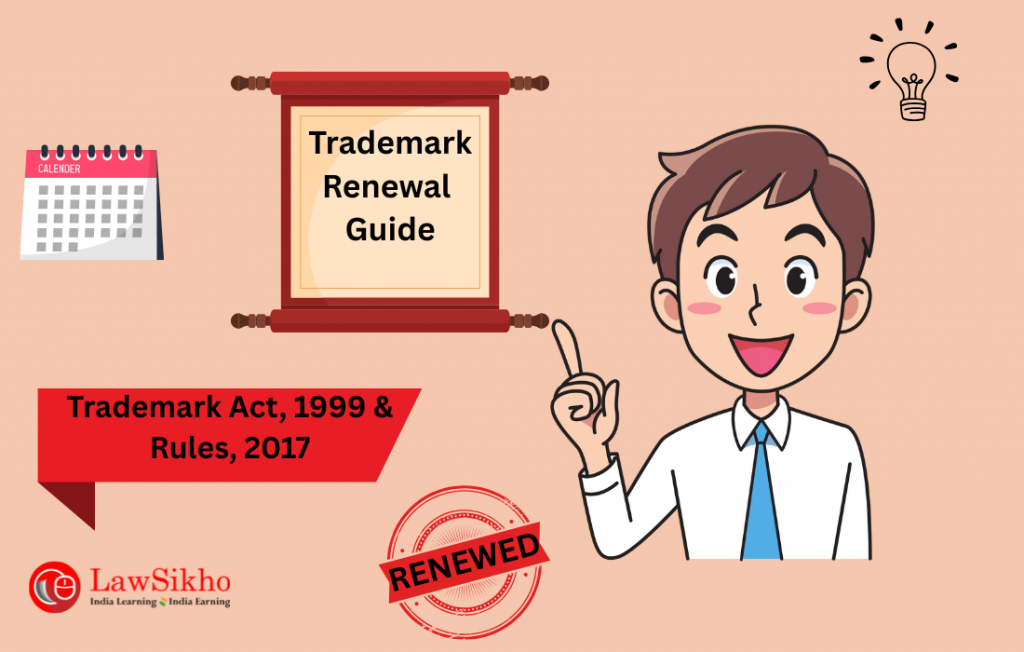Through this guide, I will provide you with a comprehensive overview of trademark renewal in India. I will outline the legal framework under the Trademark Act, 1999, and Trademark Rules, 2017, and take you through the entire process of renewal with some practical tips.
Table of Contents
Introduction
Hopefully, by now, you know all about Tara Kumar and her successful small business, Candlemoniom. If you do not, let us catch you up.
Okay, so my dearest friend Tara started a small business called Candlemoniom where she makes and sells various types of candles. I helped her through the trademark registration process and also the trademark opposition process.
But for the sake of knowledge and learning, let us fast-forward to 10 years. Why? Because then it will be time for Trademark Renewal! Also, more often than not, people realise too late that their trademark is not protected anymore because the protection period is over. Many businesses overlook trademark renewal until it is too late. But do not worry, if you keep track of deadlines and renew your trademark on time, you will never face this issue.
So today my goal is to tell Tara and you about trademark renewal so that you do not end up skipping the deadline!
What is Trademark Renewal?
Before we begin, we must first look at the definitions of trademarks. Trademarks are covered under the Trademark Act of 1999, according to section 2(1)(zb):
“Trade mark means a mark capable of being represented graphically and which is capable of distinguishing the goods or services of one person from those of others and may include shape of goods, their packaging and combination of colours”
And according to WIPO,
“A trademark is a sign capable of distinguishing the goods or services of one enterprise from those of other enterprises. Trademarks are protected by intellectual property rights.”.
What does the Act say about renewal? Under section 25(1):
“The registration of a trade mark, after the commencement of this Act, shall be for a period of ten years, but may be renewed from time to time in accordance with the provisions of this section.”
1. How long does a trademark last?
As it says in the definition, a trademark in India is valid for 10 years from the date of registration. But unlike a one-time property purchase, you do not own it forever, you need to renew it every decade to maintain your exclusive rights.
If you do not renew your trademark, it lapses, and others can apply for it. Losing your trademark means losing your brand identity, market reputation, and legal protection, a nightmare for any business owner.
2. When should you renew your trademark?
So the good news is that you do not have to wait until the last moment. According to Rule 57 of the Trademark Rules, 2017, renewal applications are to be filed up to one year before expiry.
Delaying the process unnecessarily can lead to complications, increased fees, and in worst-case scenarios, removal of your trademark from the register.
It is always best to renew your trademark as soon as the window opens. Why?
- Avoid unnecessary delays – The processing of renewal applications can take time. If you file at the last minute and face any objections or administrative delays, you may risk an unintentional lapse.
- Prevent legal uncertainty – A pending or expired trademark can create legal gray areas. While you may still have some rights for a brief period, an expired trademark can make it harder to enforce your brand protection.
- Save money – Late renewals come with additional costs. Renewing on time ensures that you pay only the standard renewal fees without penalties.
A proactive approach is always the best. It is a good idea to set reminders well in advance of the renewal period. Many businesses, especially small ones, make the mistake of forgetting about their trademark renewal until it is too late. If you are handling multiple trademarks, keeping track of renewal dates should be a priority.
3. What happens if you do not renew your trademark?
If you fail to renew your trademark within the grace period, the Registrar of Trademarks has the authority to remove your mark from the register. Once this happens, your trademark is considered abandoned, and you lose all rights associated with it.
The consequences of losing a registered trademark can be severe:
- Your brand identity becomes vulnerable. If your trademark is removed, anyone can apply for and potentially register the same or a similar mark. A competitor could legally take over your brand name, logo, or slogan, and you would have no legal recourse.
- You lose exclusive rights to your mark. A registered trademark gives you legal protection against infringement. Without it, enforcing your brand rights becomes significantly harder.
- Restoring the trademark is expensive and uncertain. If your trademark has been removed from the register, the only option left is to file for restoration. This is not a simple renewal, it requires a special application, higher fees, and a justification for why you failed to renew on time. Even then, there is no guarantee that the Registrar will approve the restoration.
Rebranding may become necessary. If someone else registers your expired trademark, you may be forced to change your brand name, logo, packaging, and marketing materials. This is not just expensive but can also cause confusion among your customers and affect your brand’s reputation for deadlines, and you will not have to worry about losing control over your brand’s identity.
Trademark renewal process
Renewing a trademark is not just about filling out a form and paying a fee; it is actually a structured process that ensures your brand remains protected under the law. If you approach it with a clear understanding of each step, you can avoid unnecessary delays, additional fees, or even rejection of your renewal application.
In this section, I will walk you through the entire renewal process so that when the time comes, you know exactly what to do.
1. Checking trademark status
The first thing you need to check is whether your trademark is eligible for renewal. Before you proceed with the renewal application, the first thing you must do is check the status of your trademark. Many businesses assume that they can simply file for renewal without verifying whether their trademark is in good standing. However, that is a mistake.
You need to ensure that:
- Your trademark is still registered – If it has already been removed from the register due to non-renewal or other legal issues, you may have to file for restoration instead of renewal.
- There are no pending disputes – If your trademark has been opposed by a third party or there are pending objections, these must be resolved before renewal.
- Your details are up to date – If your business address or ownership has changed, you may need to update the records before proceeding with renewal.
How can you check this?
You can verify the current status of your trademark by visiting the Indian Trademark Registry website and using the Trademark Search Tool. Enter your Trademark Application Number and check for any pending objections or issues.
This is the public domain where you can do your search.
- Filing Form TM-R – Online and Offline Filing Process
Once you have confirmed that your trademark is eligible for renewal, the next step is to file Form TM-R, which is the official application for trademark renewal.
This is how the form will look.
Where do you file for renewal?
You have two options for filing the renewal application:
- Online through the IP India website (recommended)
- Offline at the appropriate Trademark Registry Office
How do you file online?
- Visit the IP India e-filing portal.
- Log in or register for an account if you are a first-time user.
- Select Form TM-R (this is the application for renewal of a registered trademark).
- Fill in the required details:
- Trademark Registration Number
- Owner’s Name and Address
- Category of Renewal (with or without modification)
- Upload the necessary documents (if required).
- Pay the renewal fee online.
- Submit the application and download the acknowledgement receipt.
How to file offline?
- Download Form TM-R from the IP India website.
- Fill in the required details manually.
- Attach the required documents.
- Visit the appropriate Trademark Registry Office (based on jurisdiction).
- Submit the form along with the required fees at the counter.
- Collect the acknowledgement receipt.
Note: Online filing is faster and preferred by most businesses as it reduces paperwork and processing time.
Before we go to the next step, let me tell you what exactly should be done. Let us keep Tara’s business as our guide.
a. Application type
Here, you must specify the type of renewal, whether it is a simple renewal, a renewal with modifications, or a restoration (if the mark has expired). Since the trademark details remain unchanged, we are applying for a regular renewal.
Type of Application: Renewal of a registered trademark (without modification).
b. Registered proprietor’s details
This section confirms the trademark owner’s details, which can be yours or your clients details. The details must exactly match the original registration to avoid processing delays. These details should be carefully reviewed before submission to ensure consistency with the records in the Trademark Registry.
Applicant Name: Candlemoniom LLC
Address: 12th Lane, Mumbai, Maharashtra – 400001
Nationality: Indian
Entity Type: LLC
c. Trademark details
This section provides the essential details of the registered trademark, ensuring that the correct mark is being renewed, the registration number and expiry date are crucial for tracking the renewal.
- Trademark Name: “Candlemoniom” with a logo of a candle and flame
- Trademark Registration Number: 12345678
- Date of Original Registration: January 15, 2015
- Trademark Expiry Date: January 15, 2025
- Duration of Renewal Requested: 10 years (January 15, 2025 – January 15, 2035)
d. Trademark description
Here you need to provide a detailed description that help verify the renewal request, ensuring that no unauthorised modifications have been made to the mark. Keep in mind that any changes in design, color, or text would require a separate modification application, but this renewal keeps the trademark as originally registered.
The mark consists of the word “Candlemoniom” in a stylised bubble font, with two minimalist smiling candles holding hands.
Colours claimed: Dark brown (#654321) for the word, gold (#FFD700) for the candle, and yellow (#FFF00) for the flame.
e. Class and goods/services
Okay so keep in mind that trademark protection is granted under specific classes based on the Nice Classification system. This section ensures that the trademark remains protected under the correct categories. You must ensure that these classes remain relevant to their business. If any changes in product categories are required, a new trademark application would be needed instead of a renewal. Since Tara’s business deals with candles and scented candles, it will fall under the following categories:
Class: 3 & 4
Goods/Services: Candles, scented candles, wax melts, and candle accessories.
f. Basis for renewal
Here you need to confirm whether the trademark is still in use or if there is an intention to use it in the future. Being in use is not a mandate, but if you have been using then you can mention that/
Basis for Renewal: The trademark has been continuously used since registration and remains active in the market.
g. Specimen of trademark in use
A specimen is required to show that the trademark is still being used in commerce. This could be product packaging, labels, or marketing materials featuring the mark. Providing clear evidence of commercial use strengthens the renewal application. While not mandatory, you can always attach it in your application if your trademark is in use.
Specimen: A label showing the mark “Candlemoniom” and the candle logo on a scented candle product.
Here you can also add supporting documents include such as
- Product packaging images for eg.
- Advertisements featuring the trademark for eg.
- Business invoices
h. Declaration and verification
A legal declaration is required to confirm that the provided information is true and correct. This essentially ensures that you takes full legal responsibility for the accuracy of the details provided.
I, Tara Kumar, authorised signatory of Candlemoniom LLC, hereby declare that the information provided in this application is true and accurate to the best of my knowledge.
Signature: Tara Kumar
Date: April 1, 2035
i. Attachments
Supporting documents must be attached to avoid delays in processing. If you are the trademark owner and if you are filing directly, then a POA is not required
Copy of the previous trademark registration certificate
Specimen showing the trademark in use (product packaging, website screenshots)
Proof of business activity (e.g., invoices, advertisements using the mark)
Power of Attorney (POA) – If an agent or attorney is filing on behalf of the applicant
3. Payment of fee
The government fee for trademark renewal varies based on the mode of filing:
- Online Filing: ₹9,000 per class
- Offline Filing: ₹10,000 per class
If you fail to renew within the standard period and apply within the grace period (six months after expiry), you must pay an additional surcharge of ₹4,500 (online) or ₹5,000 (offline) per class.
Pro tip: Paying your renewal fee online not only saves money but also speeds up processing.
4. Trademark office review
Once you have submitted Form TM-R and paid the required fees, the Trademark Registrar examines your application.
What does this review process involve?
- Verification of documents – The Registrar ensures that all required details are correctly filled in and that there are no inconsistencies.
- Checking for pending issues – If there are pending oppositions, rectifications, or objections, these must be cleared before renewal can be granted.
- Modification requests (if applicable) – If you have applied for renewal with modifications, such as changing the logo or updating ownership details, the Registrar will examine the changes before granting renewal.
If everything is in order, your application proceeds to the next stage. However, if there are any discrepancies, you may receive an official notice requiring clarification or corrections. In such cases, you must respond promptly to avoid delays.
5. Publication in the trademark journal
The renewed trademark is published in the Trademark Journal for public notice.
The Trademark Journal publication allows third parties to raise objections if they believe the renewal should not be granted. If no objections are raised within the stipulated time, the renewal proceeds smoothly.
If objections arise, you may need to respond with legal arguments or appear for a hearing before the Trademark Registrar.
6. Receiving the renewal certificate
Once your application is approved, the Trademark Registry issues the Trademark Renewal Certificate. This certificate is proof that your trademark has been successfully renewed for another 10 years.
How will you receive the certificate?
- If you filed online, you can download the renewal certificate from the IP India portal.
- If you filed offline, the certificate is sent to your registered address via post.
This certificate should be safely stored along with your other business documents. It serves as evidence of your continued trademark rights and may be required in legal proceedings, licensing agreements, or business transactions.
Now, what if you miss the deadline for renewal?
Trademark restoration
It is okay, sometimes deadlines slip through the cracks. You might have been caught up in business expansion, dealing with legal paperwork, or simply missed the reminder. But when it comes to trademark renewal, missing the deadline can have serious consequences.
If you fail to renew your trademark within the standard 10-year period, you still have a grace period of six months to file for renewal. However, missing this extended deadline means your trademark will be removed from the register, and once that happens, getting it back is neither easy nor guaranteed.
Grace period and additional fees
If your trademark expires, you still have a six-month grace period to renew it, but at an additional cost. This means:
- You can still file Form TM-R for renewal, but you must pay a late surcharge in addition to the renewal fees.
- If the renewal is not completed within this grace period, the Registrar will strike off your trademark from the register, meaning your brand loses its legal protection.
For instance, if your trademark expired on January 1, 2030, you have until July 1, 2030, to apply for renewal. After that, your trademark is considered abandoned, and the only option left is restoration, which is more complicated and expensive than a regular renewal.
Filing for trademark restoration
If your trademark has already been removed from the register, you still have one last opportunity to restore it, but you must act fast. Under section 25(4) of the Trade Marks Act, 1999, restoration is possible after six months and within one year from the expiration of the last registration. You need to file Form TM-R along with an additional restoration fee.
Here is what the restoration process involves:
- Filing Form TM-R – This is the same form used for renewal, but you must clearly specify that you are applying for restoration, not just renewal.
- Paying the restoration fee – The government charges a higher fee for restoration, making it more expensive than a standard renewal.
- Providing a justification – The Registrar may require a valid reason for why you failed to renew the trademark on time. If the justification is weak or unjustified, the Registrar has the right to reject the restoration request.
- Review and approval – If the Trademark Registry is satisfied with your request, they will restore the trademark, and it will be treated as if it had never expired.
If you do not renew or restore your trademark within the allowed time, it gets permanently removed from the register. This means:
- You lose all exclusive rights to the trademark.
- Anyone else can apply for the same or a similar trademark, potentially leading to legal battles if they start using your brand identity.
- You may have to rebrand, which could be costly in terms of new marketing materials, domain names, and customer recognition.
Many businesses assume that they can simply re-file for a new trademark, but this is risky. If another party has already applied for a similar mark, your application could be rejected, leaving you in a difficult position.
Practical tips for hassle-free renewal
Trademark renewal does not have to be a stressful, last-minute task. With a few simple strategies, you can ensure a smooth renewal process without any panic or unnecessary fees.
1. Keeping track of renewal deadlines
The biggest mistake businesses make is forgetting their renewal dates. Unlike tax filings or business permits, trademark renewal is only required once every 10 years, making it easy to overlook. But forgetting could mean losing years of branding efforts.
What can you do?
- Maintain a trademark renewal calendar for all your intellectual property.
- Review your trademark portfolio annually to check upcoming deadlines.
- Assign a team member or department to oversee trademark management.
2. Setting up alerts for trademark expiry dates
Instead of relying on memory or manual tracking, you can set up automated alerts to remind you about upcoming renewals.
Here is how:
- Use Google Calendar, Outlook, or trademark management software to create reminders, it can be as simple as a reminder on your phone.
- Set multiple alerts, one at 12 months before expiry, another at 6 months before expiry, and a final reminder at 3 months before expiry.
- If you have multiple trademarks, organise them by expiry dates to avoid confusion.
These simple steps ensure you never miss a renewal deadline and avoid unnecessary restoration fees or legal risks.
3. Hiring a professional for smooth processing
If you own multiple trademarks or handle a large brand portfolio, it may be wise to hire a trademark attorney or IP professional. Why?
- They track deadlines for you, ensuring that renewals are handled on time.
- They manage paperwork and filings, reducing errors that could delay your renewal.
- They advise on modifications (such as updating the owner’s details or making changes to your trademark).
Professional assistance is especially useful if your trademark is facing objections, renewal complications, or cross-border registrations.
Common mistakes to avoid
While trademark renewal is a relatively straightforward process, small mistakes can lead to delays, extra costs, or even the loss of your trademark. Here are some common pitfalls to watch out for:
1. Waiting until the last minute
Many businesses assume that six months before expiry is plenty of time, but this is a risky approach. Delays in processing, administrative errors, or objections could lead to last-minute panic or missing the deadline entirely.
The best practice? Renew your trademark as soon as the renewal window opens.
2. Incorrect details in the application
Even a small mistake in the renewal application, such as a misspelt name, wrong address, or incorrect trademark number, can result in delays or rejection.
Before submitting Form TM-R, double-check that:
- The trademark registration number is accurate.
- The owner’s name and address are up to date.
- The correct renewal category is selected (standard renewal or renewal with modification).
Taking the time to review your application carefully can prevent unnecessary back-and-forth with the Trademark Office.
3. Ignoring trademark watch services
Even if you renew your trademark on time, you should not assume that your brand is completely protected.
Trademark watch services monitor newly filed trademarks to identify any potentially conflicting applications. If a competitor tries to register a similar mark, you will be notified so you can take action before it becomes a bigger problem.
For businesses in competitive industries, using a trademark watch service can prevent unauthorised use of similar brand names and help you maintain exclusive rights.
Conclusion
Trademark renewal is not just a legal obligation, it is a critical step in protecting your brand identity. Your trademark represents the reputation, goodwill, and recognition your business has built over the years. Losing it due to negligence or missed deadlines can be costly, both financially and legally. By taking a proactive approach, you can ensure that your trademark remains valid without unnecessary stress.
A well-maintained trademark is a valuable asset. By staying ahead of your renewal deadlines, you secure your brand’s legal protection and maintain your competitive edge in the market.






 Allow notifications
Allow notifications
